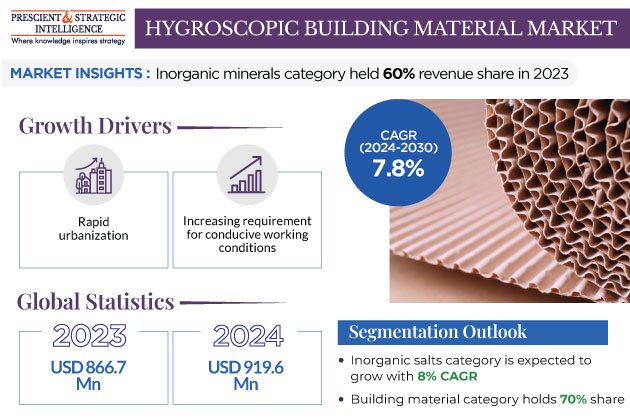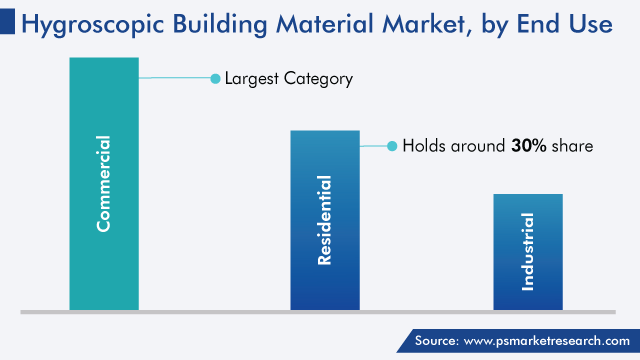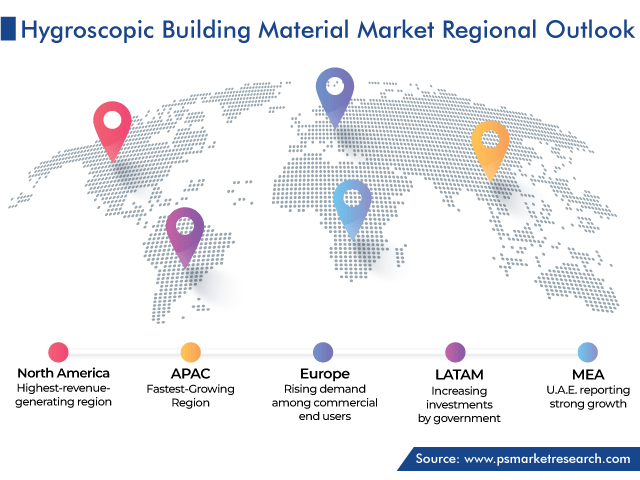Report Code: 12867 | Available Format: PDF | Pages: 240
Hygroscopic Building Material Market Size and Share Analysis by Type (Inorganic Minerals, Inorganic Salts, Natural Hygroscopic Materials, Molecular Sieve, Silica/Silicon Dioxide), Adsorption Process (Physical, Chemical), End Use (Commercial, Residential, Industrial), Application (Building, Structural) - Global Industry Revenue Estimation and Demand Forecast to 2030
- Report Code: 12867
- Available Format: PDF
- Pages: 240
- Report Description
- Table of Contents
- Market Segmentation
- Request Free Sample
Hygroscopic Building Material Market Outlook
The hygroscopic building material market generated revenue of USD 866.7 million in 2023, which is expected to witness a CAGR of 7.8% during 2024–2030, reaching USD 1,443.5 million by 2030. This will be due to the rising demand for residential, commercial, and industrial buildings, population growth, rapid urbanization, modification of people’s lifestyle, increasing requirement for conducive working conditions, and post-pandemic recovery.

- The construction industry faced challenges due to the COVID-19 pandemic, such as a lack of labor, health issues, travel restrictions, and disruptions in the supply chain.
- This halted and delayed the projects, which further affected the demand for hygroscopic building materials.
- Then, the reduction in COVID-19 cases and proper execution of containment strategies by government and non-government bodies helped the market expand.
Inorganic Mineral Category Has Largest Market Share
The inorganic minerals category dominated the market, with a share of 60%, in 2023. This is due to the increasing demand for these materials for structural applications and the broad range of applications of concrete since it possesses hygroscopic attributes, low cost, and simple accessibility. Clays are an essential ingredient of ceramics, plasters, and bricks owing to their excellent strength, thermal resistance, and durability.
- They hold a significant share due to their vast adaptability and widespread use.
- Because of their affordability and reliability, they are currently in high demand. This factor creates a regular demand for them despite fluctuations in economic conditions.
- Their sustainability and friendliness also contribute to their dominance.
- The use of inorganic minerals and clays is becoming more prevalent as the world is progressing toward green practices, owing to their easy availability and minimal impact on the environment.
Furthermore, the rigorous advancements in technology boosted their utility, driven by the ongoing research and development initiatives. These materials now have wider applications, thus enhancing their significance in the evolving construction industry. This ability to adjust according to the changing consumer demands and market conditions has cemented their position as market leaders.
Inorganic Salts Are Expected To Be Fastest-Growing
The inorganic salts category is expected to witness the highest CAGR, of 8%, from 2024 to 2030. These salts absorb and release moisture, making them suitable for materials designed to adjust indoor humidity. Hence, the widespread acceptance of inorganic salts is due to enhanced focus on developing healthier indoor environments. As people are becoming more concerned about indoor air quality and its impact on wellbeing, materials that actively manage moisture and suppress the growth of mold are gaining limelight.
Adaptability to different materials and applications is another factor for the expansion in the usage of these salts. Further, by spending money on research and development, the efficacy and application potential of inorganic salts is being increased.
- Inorganic salts are added to coatings, plasters, and cement materials to enhance their performance and durability, which contributes to the improvement of building lifespan and structural integrity.
- Additionally, inorganic salts are extracted from natural sources, which makes them ideal for use in buildings amidst the growing need for eco-friendly materials.
- Since the origin is natural, they become an excellent option for modern construction projects. They reduce the problems of dryness and dampness owing to their hygroscopic properties.
Many inorganic salts have hygroscopic qualities, such as potassium carbonate and lithium chloride, which means they absorb moisture from the air and contribute to indoor humidity maintenance. Further Calcium chloride is a widely used inorganic salt as it offers higher efficiency compared to other hygroscopic materials, such as silica/silicon dioxide and clay. This is why it is widely used for gravel stabilization, concrete acceleration, dust control, and other applications in the building & construction industry. In these applications, small and coarse gravel particles are attached together by calcium chloride, which draws moisture from the air and retains it during construction and maintenance, to prevent road degradation.
- As the focus of the construction industry shifts toward resilient, sustainable, and healthier environments, inorganic salts will continue to grow fast in the market. Their extraordinary qualities, combined with their flexibility and significance in today’s construction challenges, make inorganic salts pivotal players in nurturing the future of the construction industry.
| Report Attribute | Details |
Market Size in 2023 |
USD 866.7 Million |
Market Size in 2024 |
USD 919.6 Million |
Revenue Forecast in 2030 |
USD 1,443.5 Million |
Growth Rate |
7.8% CAGR |
Historical Years |
2017-2023 |
Forecast Years |
2024-2030 |
Report Scope |
Market Trends, Drivers, and Restraints; Revenue Estimation and Forecast; Segmentation Analysis; Impact of COVID-19; Companies’ Strategic Developments; Market Share Analysis of Key Players; Company Profiling |
Segments Covered |
By Type; By Adsorption Process; By End Use; By Application; By Region |
Explore more about this report - Request free sample
Building Material Is Projected To Have Larger Share
The building material category in the application segment is dominating the market with a share of 70%. These superior building materials help maintain the desired indoor air quality, control moisture, and are sustainable.
- Several hygroscopic building materials, such as amorphous silica, calcium oxides, and activated alumina, are in extensive usage owing to their brilliant moisture adsorption ability and importance in concrete and dewatering additives.
- Concrete is made from fine aggregates (sand), cement, and coarse aggregates mixed with water.
The dominance of this category on the hygroscopic building material market is due to the effectiveness in regulating moisture, adaptability to the changing industry trends, and versatility in a range of applications and climates. These qualities make them an ideal choice for builders and architects seeking Effective solutions to manage moisture and improve indoor environments. This is why they find wide application in walls, flooring, and insulation.
Residential Category Is Expected To Hold Significant Market Share
The residential category is predicted to hold a share of 30% in 2030.
- A number of factors, such as urbanization, the changing lifestyles, population growth, and shifting consumer demands, contribute to the high pace of housing development.
- The government initiatives in developed and developing nations to provide housing to all are the key factors for the growth in residential construction.
- The need for cost-effective single-family homes and apartments, keeps growing because of the booming urban population, especially in emerging economies.
Further, the popularity of eco-friendly building materials and designs is surging due to the increasing emphasis on energy-efficient homes and sustainable buildings. Innovative construction approaches and technologies that encourage sustainability, healthy living, and energy efficiency are being rapidly adopted in the residential real estate sector. The anticipated market share of this category is mainly due to the focus on sustainability.
- The COVID-19 pandemic has also played a role in the market growth as it has brought about the trend of remote work.
- There is an increase in the demand for homes with multifunctional spaces, enhanced comfort, and improved amenities, as people spend more time at home.
- This leads to the need for creative construction materials and designs.

APAC Is Set To Emerge as Fastest-Growing Region
Geographically, APAC is expected to grow with a CAGR of 10% from 2024 to 2030 in the market. The availability of inexpensive labor and materials, as well as the growing domestic demand for construction, makes it an attractive destination to invest for the manufacturers of hygroscopic building materials. Other powerful factors that drive the market here are urbanization, rising population, and growing concerns for sustainability in construction in India and China. In this region, China is the largest market.
- Several countries, including India, China, and Southeast Asian countries, have been experiencing tremendous economic growth of late.
- This is leading to increasing investments in construction projects across the residential, commercial, industrial, and civic/utilities sectors.
- Along with the rising infrastructure investment, the technological advancements in building materials and technologies propel the market in the region
In addition, the progress of APAC is greatly facilitated by government efforts. Presently, governments across the region are focused on smart cities, sustainable urban development, and transit networks. This is creating a lot of bright opportunities for the construction industry by driving the demand for materials that not only help building strong structures but also help achieve sustainability both during and after the construction phase.

Competitive Analysis
founded in 1947, Porocel Corporation is one of the largest global producers of hygroscopic building materials.
- It has expanded rapidly, and it now offers a broad range of products, including activated alumina, molecular sieves, and silica gels.
W. R. Grace & Co., founded in 1854, is another major company in the market.
- It offers many products of building materials with desiccants and silica gels, which help in management of the humidity.
- The global presence and wide product portfolio allow the company to maintain its strong position in the market.
BASF SE, one of the largest chemical companies in the world, also operates in the market.
- It offers a wide range of hygroscopic materials for construction applications, such as molecular sieves and silica gels.
- BASF, which already enjoys a strong presence globally, has been working continuously to expand its position in the construction industry.
Recent Developments
In June 2021, W. R. Grace & Co. fully acquired Albemarle’s fine chemistry services business to enhance Grace’s capacity for innovation and development in the material technologies field.
Top Providers of Hygroscopic Building Materials Are:
- Porocel Corporation
- W.R. Grace & Co.
- Clariant AG
- BASF SE
- Arkema AS
- Honeywell International Inc.
- Jalon Chemicals
- Hengye Inc.
- Dessica Chemicals Pvt. Ltd.
- Fuji Silysia Chemical Ltd.
Market Size Breakdown by Segment
The report analyzes the impact of the major drivers and restraints on the hygroscopic building material market, to offer accurate market estimations for 2017–2030.
Based on Type
- Inorganic Minerals
- Inorganic Salts
- Natural Hygroscopic Materials
- Molecular Sieve
- Silica/Silicon Dioxide
Based on Adsorption Process
- Physical
- Chemical
Based on End Use
- Commercial
- Residential
- Industrial
Based on Application
- Building
- Structural
Region/Countries Reviewed for this Report
- North America
- U.S.
- Canada
- Europe
- Germany
- U.K.
- France
- Italy
- Spain
- Asia-Pacific
- Japan
- China
- India
- South Korea
- Australia
- Latin America
- Brazil
- Mexico
- Middle East and Africa
- Saudi Arabia
- South Africa
- U.A.E.
Explore
Want a report tailored exactly to your business strategy?
Request CustomizationWant an insight-rich discussion with the report author?
Speak to AnalystOur dedication to providing the most-accurate market information has earned us verification by Dun & Bradstreet (D&B). We strive for quality checking of the highest level to enable data-driven decision making for you
Our insights into the minutest levels of the markets, including the latest trends and competitive landscape, give you all the answers you need to take your business to new heights
With 24/7 research support, we ensure that the wheels of your business never stop turning. Don’t let time stand in your way. Get all your queries answered with a simple phone call or email, as and when required
We take a cautious approach to protecting your personal and confidential information. Trust is the strongest bond that connects us and our clients, and trust we build by complying with all international and domestic data protection and privacy laws